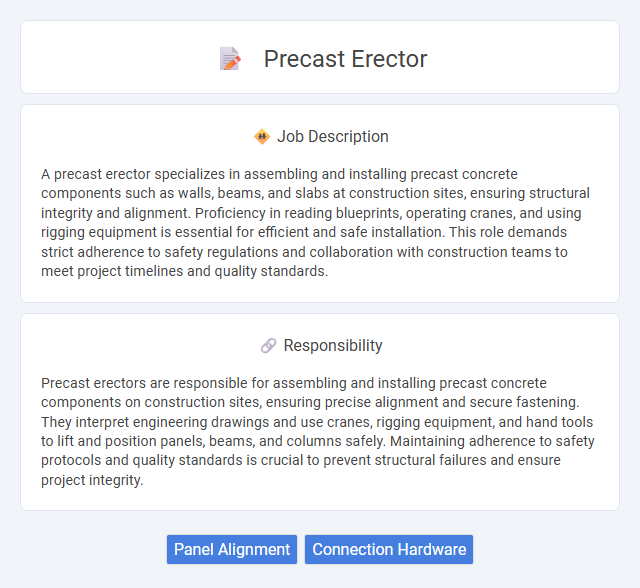
A precast erector specializes in assembling and installing precast concrete components such as walls, beams, and slabs at construction sites, ensuring structural integrity and alignment. Proficiency in reading blueprints, operating cranes, and using rigging equipment is essential for efficient and safe installation. This role demands strict adherence to safety regulations and collaboration with construction teams to meet project timelines and quality standards.
Individuals with strong physical stamina and good hand-eye coordination are likely suitable for a precast erector job, as the role often involves lifting heavy materials and precise placement. Those comfortable working at heights and in varying weather conditions may find this job more fitting. Candidates with a keen attention to safety protocols and the ability to work well in a team environment will probably excel in this position.
Qualification
A precast erector must have a solid understanding of construction blueprints, safety regulations, and crane operations to accurately position and secure precast concrete components. Certification in rigging and heavy equipment operation enhances their ability to handle precast elements safely and efficiently on-site. Physical stamina, attention to detail, and experience in structural assembly are critical qualifications for ensuring structural integrity and project timelines.
Responsibility
Precast erectors are responsible for assembling and installing precast concrete components on construction sites, ensuring precise alignment and secure fastening. They interpret engineering drawings and use cranes, rigging equipment, and hand tools to lift and position panels, beams, and columns safely. Maintaining adherence to safety protocols and quality standards is crucial to prevent structural failures and ensure project integrity.
Benefit
Precast erectors likely benefit from enhanced job efficiency due to the use of pre-manufactured components, which can reduce on-site construction time and labor costs. They may experience improved safety conditions, as precast elements often require less manual handling and heavy lifting at height. The specialized skills gained in this role could increase employability and open opportunities for career advancement in the construction industry.
Challenge
Precast erector jobs likely involve navigating complex construction environments where precision and coordination are critical to safely lifting and placing heavy precast concrete components. Workers probably face challenges related to timing, weather conditions, and equipment reliability, requiring strong problem-solving skills and adaptability. The role may demand constant attention to safety protocols and teamwork to manage the risks associated with working at heights and with large structural elements.
Career Advancement
Precast erectors specializing in the installation of precast concrete components on construction sites have strong opportunities for career advancement through gaining expertise in structural engineering and project management. Mastery of safety protocols, rigging techniques, and equipment operation can lead to supervisory or foreman roles, increasing earning potential and leadership responsibilities. Pursuing certifications such as OSHA or NCCER enhances credibility, opening pathways to senior positions or transitioning into related fields like construction management or quality control.
Key Terms
Panel Alignment
Precast erectors specialize in the precise alignment of concrete panels during construction, ensuring structural integrity and seamless installation. Utilizing advanced tools like laser levels and alignment bars, they position panels according to engineering specifications to maintain safety and stability. Expertise in panel alignment reduces installation errors and accelerates project timelines in building frameworks.
Connection Hardware
Precast erectors specialize in assembling and installing precast concrete components using high-strength connection hardware such as steel plates, anchor bolts, and lifting inserts to ensure structural integrity. Proper handling and precise alignment of these connection elements are critical for achieving secure joints and meeting engineering specifications. Expertise in interpreting structural drawings and safely implementing connection hardware enhances construction efficiency and safety on-site.
 kuljobs.com
kuljobs.com